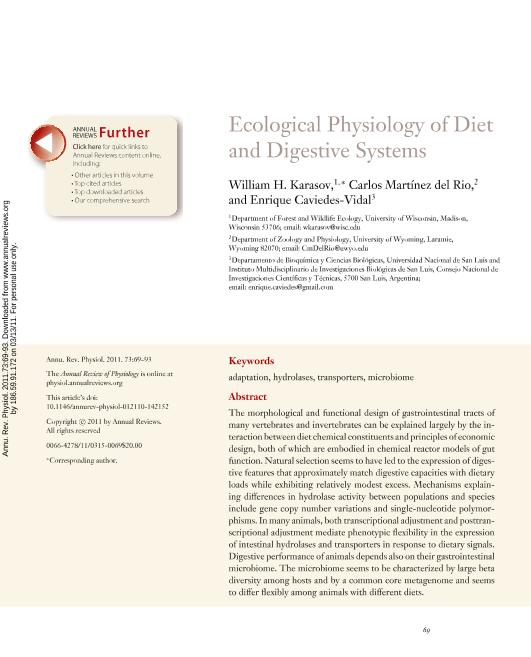Mostrar el registro sencillo del ítem
dc.contributor.author
Karasov, William H.
dc.contributor.author
Martinez del Rio, Carlos
dc.contributor.author
Caviedes Vidal, Enrique Juan Raul

dc.date.available
2017-04-03T18:14:30Z
dc.date.issued
2011-03
dc.identifier.citation
Karasov, William H.; Martinez del Rio, Carlos; Caviedes Vidal, Enrique Juan Raul; Ecological physiology of diet and digestive systems; Annual Reviews; Annual Review Of Physiology.; 73; 3-2011; 69-93
dc.identifier.issn
0066-4278
dc.identifier.uri
http://hdl.handle.net/11336/14704
dc.description.abstract
The morphological and functional design of gastrointestinal tracts of many vertebrates and invertebrates can be explained largely by the interaction between diet chemical constituents and principles of economic design, both of which are embodied in chemical reactor models of gut function. Natural selection seems to have led to the expression of digestive features that approximately match digestive capacities with dietary loads while exhibiting relatively modest excess. Mechanisms explaining differences in hydrolase activity between populations and species include gene copy number variations and single-nucleotide polymorphisms. In many animals, both transcriptional adjustment and posttranscriptional adjustment mediate phenotypic flexibility in the expression of intestinal hydrolases and transporters in response to dietary signals. Digestive performance of animals depends also on their gastrointestinal microbiome. The microbiome seems to be characterized by large beta diversity among hosts and by a common core metagenome and seems to differ flexibly among animals with different diets.
dc.format
application/pdf
dc.language.iso
eng
dc.publisher
Annual Reviews

dc.rights
info:eu-repo/semantics/openAccess
dc.rights.uri
https://creativecommons.org/licenses/by-nc-sa/2.5/ar/
dc.subject
Adaptation
dc.subject
Hydrolases
dc.subject
Transporters
dc.subject
Microbiome
dc.subject
Absorption
dc.subject.classification
Zoología, Ornitología, Entomología, Etología

dc.subject.classification
Ciencias Biológicas

dc.subject.classification
CIENCIAS NATURALES Y EXACTAS

dc.title
Ecological physiology of diet and digestive systems
dc.type
info:eu-repo/semantics/article
dc.type
info:ar-repo/semantics/artículo
dc.type
info:eu-repo/semantics/publishedVersion
dc.date.updated
2017-03-30T17:42:27Z
dc.journal.volume
73
dc.journal.pagination
69-93
dc.journal.pais
Estados Unidos

dc.journal.ciudad
Palo Alto
dc.description.fil
Fil: Karasov, William H.. University of Wisconsin; Estados Unidos
dc.description.fil
Fil: Martinez del Rio, Carlos. University of Wyoming. Department of Zoology and Physiology; Estados Unidos
dc.description.fil
Fil: Caviedes Vidal, Enrique Juan Raul. Consejo Nacional de Investigaciones Científicas y Técnicas. Centro Científico Tecnológico San Luis. Instituto Multidisciplinario de Investigaciones Biológicas de San Luis; Argentina. Universidad Nacional de San Luis. Facultad de Quimica, Bioquimica y Farmacia. Departamento de Bioquímica y Ciencias Biológicas; Argentina
dc.journal.title
Annual Review Of Physiology.

dc.relation.alternativeid
info:eu-repo/semantics/altIdentifier/url/http://www.annualreviews.org/doi/10.1146/annurev-physiol-012110-142152
dc.relation.alternativeid
info:eu-repo/semantics/altIdentifier/doi/http://dx.doi.org/10.1146/annurev-physiol-012110-142152
Archivos asociados
